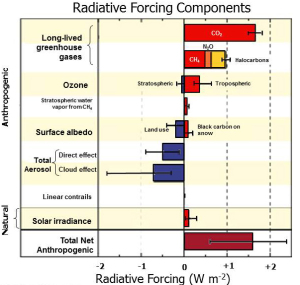Why Hasn’t it Warmed More?
Why Hasn’t it Warmed More?
Looking at the ice core data over the last 800,000 years, a carbon dioxide level of 300 ppm correlates with an increased temperature of almost 4 degrees Celsius. Currently the carbon dioxide in our atmosphere is over 400 ppm, but we’re only at about 1 degree warming. So why hasn’t it warmed more? We can point to at least two reasons. Much of the heat so far has been taken up by the oceans. And also aerosols,related to human activity, have increased in the atmosphere to cause cooling.
Oceans Taking Up Heat: Our oceans have taken up most of the heat so far. According to the U.S. Climate Science Special Report (2017), the world’s oceans have absorbed about 93 percent of the excess heat caused by greenhouse gases since the mid-20th century. Further, the oceans have absorbed more than a quarter of the CO2 emitted. The latter does two things: keeps the CO2 out of the atmosphere and causes acidification which threatens coral and other fragile ecosystems.
Aerosol Effect: Aerosols (tiny particles) cool the planet by direct shading (like smoke) and by forming clouds, which also shade. This shading partly counters the heating caused by greenhouse gases.
This can be seen in the chart on the right, showing radiative forcing  components from the IPCC 2007 report. Components which cause heating are shown in warm colors. The largest is CO2. Other greenhouse gases – methane (CH4), nitrous oxide (N2O) and halocarbons – also contribute significantly to warming.
components from the IPCC 2007 report. Components which cause heating are shown in warm colors. The largest is CO2. Other greenhouse gases – methane (CH4), nitrous oxide (N2O) and halocarbons – also contribute significantly to warming.
But notice the Total Aerosols on the left of the bar. Aerosols are very small particles put into the air predominantly by pollution from burning of fossil fuels. They cause shading (like smoke) – the Direct Effect – and they provide nuclei for condensation of water vapor to form clouds – the Cloud Effect. Both cause cooling.
The net Radiative Forcing, i.e. the sum of all components, is about 1.67. If we subtract the aerosol effects, warming would be much higher. Unfortunately, the greenhouse gases will stay in the atmosphere and warm for centuries, but the aerosols can deplete in years, months, or even weeks.
Global average temperatures continue to rise, but irregularly and slowly.
There was a slowing of temperature increase from 1998 to 2012 which made some wonder whether climate change was slowing. The “flattening” of the temperature curve was at least partly due to an after effect of the record 1998 El Niño year, and a negative phase of the lesser-known Pacific Decadal Oscillation caused shifts in ocean circulation patterns that moved some excess heat into the deep ocean.
One needs to look at the overall trend to understand climate. Like seven high waves in a row doesn’t necessarily mean the tide is coming in, short trends in temperature do not indicate climate. The temperature long-term trend tells us that climate change is happening, and indeed, accelerating.
Last update November 17, 2018
